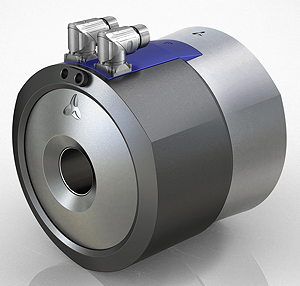- Home » News » Technology News
‘Revolutionary’ gearhead wins €100,000 technology award

UPDATED: The German motion specialist Wittenstein has won a €100,000 technology award for a new generation of compact, zero-backlash gearheads with independently movable teeth that, it claims, will outperform any previous gearhead technology in terms of torque density, torsional stiffness and energy efficiency. When the Galaxie gearhead is combined with a new high-speed motor and Industry 4.0 connections, it will pave the way to “an entirely new class of drive system”, says the company.
The company won the Hermes Award – said to be the world’s most valuable technology prize – at the recent Hannover Fair, beating almost 70 rivals, including ABB’s two-armed YuMi robot.
Compared to similar-sized conventional gearheads, Wittenstein claims that its new hollow-shaft design will deliver:
• maximum torque levels that are 70–170% higher;
• emergency-stop torque levels that are 150–300% higher;
• torsional rigidity that is 340–580% better;
• an efficiency that is 18–29% higher; and
• a ratio of hollow shaft to outer diameters that is 3–70% bigger.
Based on initial applications, Wittenstein says there is “strong evidence that the Galaxie will propel drive system engineering into a completely new performance universe”.

It adds that the compact gearhead represents “a completely new and innovative drive system design” in which each tooth is an independent and dynamic entity. Unlike conventional technologies with linear gear tooth contacts, the gearhead transmits power via a ring gear which generates much larger hydrodynamic surface contact.
The moveable gear teeth are arranged in such a way that all of the surfaces of each tooth can engage with the teeth of the fixed outer ring gear. The teeth are driven by a combination of a polygon on the input shaft and, on the output side, a segmented anti-friction bearing and a tooth carrier with a segmented outer bearing ring. The meshing pattern is a logarithmic spiral – claimed to be the first of its type.
The system boasts zero backlash, even at the zero crossing, while retaining full stiffness and no reduction in the transmittable torque. It has more than six times the internal hydrodynamic surface contact area of a traditional gearhead with the same outer diameter, allowing it to achieve torque and stiffness characteristics many times higher than was previously possible.
Wittenstein predicts that the new gearhead will open up “a new universe of high-performance drive system possibilities for the manufacturing and handling technology sectors”. Potential applications include machine tools, robots, wind turbines and textile machines.
Wittenstein has combined the drive with a newly developed high-performance motor to form an ultra-compact, hollow-shaft drive system with built-in Industry 4.0 connections.
Wittenstein says that it adopted a “no compromise” approach when developing the new drive system. Instead of constraining the design when technical challenges arose, the key performance characteristics were optimised independently, but realised together.





